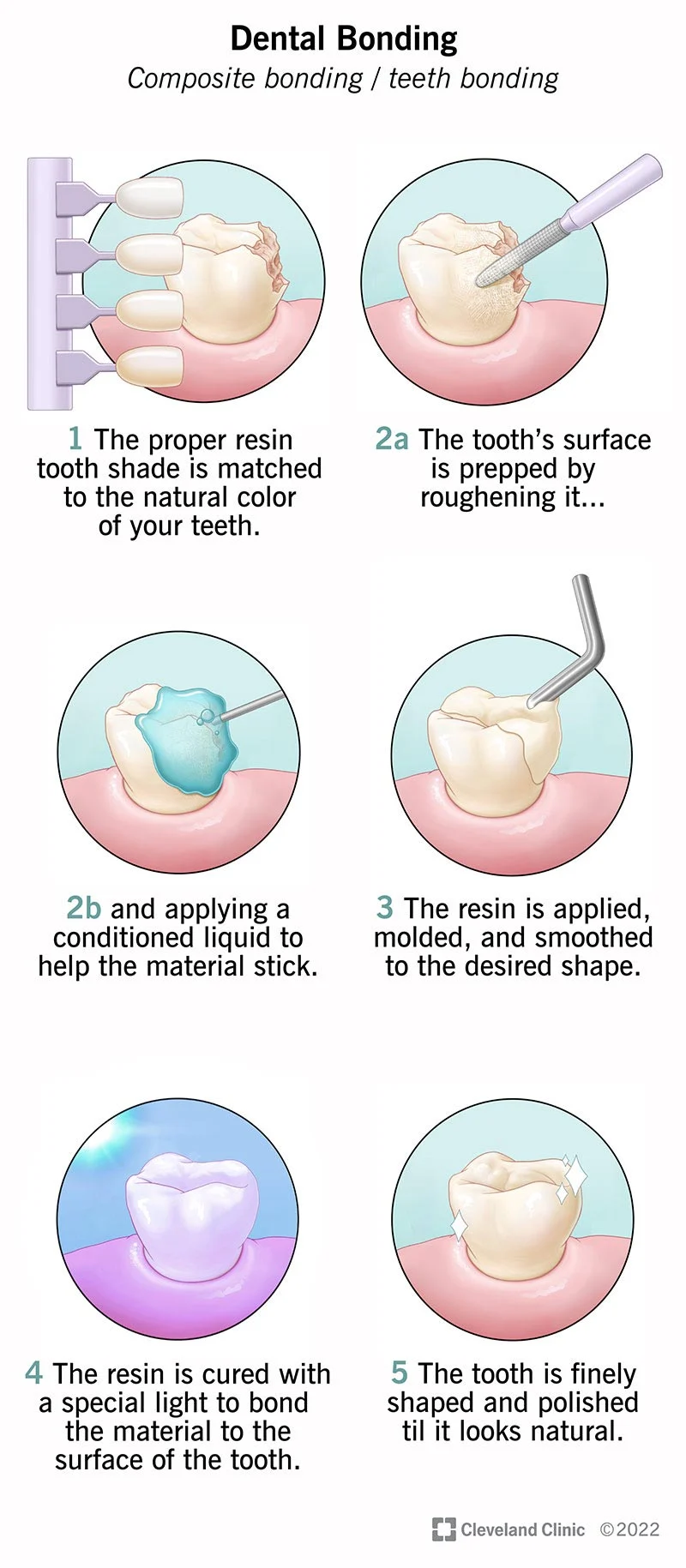
How Is Dental Bonding Done?
Dental bonding is a popular cosmetic dental procedure that can improve the appearance of teeth by fixing imperfections such as chips, cracks, discoloration, and gaps. It is a relatively quick and affordable treatment that can be done in a single visit to the dentist’s office.
1. The Procedure
- Surface Preparation: The tooth surface is roughened, and a conditioning liquid is applied to enhance bonding material adherence.
- Resin Application: Dentist applies tooth-colored resin, shaping and smoothing it for the desired outcome.
- Hardening Process: A special light is used to harden the resin, followed by final adjustments for proper fit and appearance.
2. Benefits of Dental Bonding
- Non-Invasiveness: Unlike veneers or crowns, bonding is less invasive, preserving natural tooth structure.
- Time Efficiency: Completed in a single visit, offering immediate results and saving patient time.
- Versatility: Resin matches natural teeth, seamlessly restoring appearance, filling gaps, reshaping, and covering stains.
- Painless Procedure: Generally painless, with minimal discomfort during and after treatment.
3. The Longevity of Dental Bonding
- Durability: Bonding is durable, but the material is not as strong as natural teeth.
- Care and Maintenance: Proper care, avoiding biting hard objects, and regular dental hygiene extend the bonding’s lifespan.
4. Cost of Dental Bonding
- Variable Costs: Depend on factors like the number of teeth treated and case complexity.
- Average Range: Typically ranges from $100 to $400 per tooth.
- Consultation: Essential to obtain an accurate cost estimate based on individual needs.
5. Alternatives to Dental Bonding
- Veneers: Thin shells of porcelain or composite resin providing a more permanent solution, lasting 10-15 years or longer.
- Teeth Whitening: Addresses stains and discoloration, enhancing overall tooth appearance.
- Individual Consideration: Alternatives vary based on specific dental needs and preferences.
In conclusion, dental bonding is a versatile and affordable cosmetic dental procedure that can enhance the appearance of teeth. It offers immediate results with minimal discomfort and can be completed in a single visit to the dentist’s office. With proper care and maintenance, dental bonding can last for several years, providing patients with a beautiful and confident smile.
Key Takeaways: How Is Dental Bonding Done?
- Dental bonding is a procedure used to repair or improve the appearance of teeth.
- The dentist will prepare the tooth by roughening its surface and applying a conditioning liquid.
- A tooth-colored resin material is then applied to the tooth and shaped to match the desired look.
- The resin is hardened using a special light and then polished to give it a natural appearance.
- Dental bonding is a quick and painless procedure that can be completed in one visit to the dentist.
Frequently Asked Questions
What is dental bonding?
Dental bonding is a cosmetic dental procedure that involves the application of a tooth-colored resin material to the teeth. It is used to repair chipped, cracked, or discolored teeth, as well as to close gaps between teeth and improve the overall appearance of your smile.
The bonding material is carefully sculpted and shaped to match the natural contours of your teeth, and then hardened with a special light. This process bonds the material to your teeth, resulting in a strong and durable restoration that blends seamlessly with your natural teeth.
How is dental bonding done?
The first step in dental bonding is the preparation of the tooth surface. The dentist will lightly roughen the surface of the tooth to ensure proper adhesion of the bonding material. An etching solution may also be applied to further enhance the bond.
Next, the dentist will apply the tooth-colored resin material to the tooth. They will carefully mold and shape the material to achieve the desired result. Once the material is in place, a special light is used to harden and bond it to the tooth. After the material has hardened, the dentist will polish it to give it a natural appearance.
Is dental bonding a painful procedure?
No, dental bonding is generally not a painful procedure. The process is minimally invasive and usually does not require any anesthesia. However, if the bonding is being done to repair a decayed tooth or to fill a cavity, a local anesthetic may be used to numb the area.
Some patients may experience temporary sensitivity or discomfort after the procedure, but this typically subsides within a few days. If you have any concerns about pain or discomfort, be sure to discuss them with your dentist before the procedure.
How long does dental bonding last?
The lifespan of dental bonding can vary depending on several factors, including the location of the bonding and your oral hygiene habits. On average, dental bonding can last between 3 and 10 years.
It is important to take good care of your bonded teeth to prolong their lifespan. This includes practicing good oral hygiene, avoiding biting on hard objects, and avoiding habits such as nail-biting or chewing on pens, which can damage the bonding material.
Can dental bonding be repaired or redone?
Yes, dental bonding can be repaired or redone if necessary. Over time, the bonding material may chip, stain, or become worn. If this occurs, your dentist can easily repair or replace the bonding to restore its appearance and functionality.
It is important to visit your dentist regularly for check-ups and cleanings to ensure that your bonded teeth are in good condition. Your dentist will be able to assess the condition of the bonding and recommend any necessary repairs or touch-ups.
Dental Bonding Video | Tooth Bonding
Final Summary: Dental Bonding Made Simple!
Unveiling the secrets of dental bonding! This versatile procedure effectively addresses issues like chipped teeth, gaps, and discoloration by seamlessly applying a tooth-colored resin. Beyond aesthetics, dental bonding enhances confidence and self-esteem, allowing you to smile freely without worrying about imperfections. The quick and painless process transforms your smile efficiently. If considering dental bonding, consult your dentist to determine eligibility. This procedure can fulfill your dream smile, boosting confidence and leaving you grinning. Bid farewell to dental imperfections and welcome a radiant smile. Take the leap into your dental bonding journey today for a transformative experience!
Call or Book appointment online
:Ace Dental Care Alpharetta office: 678-562-1555 - Book Now
Ace Dental Care Norcross office: 770-806-1255 - Book Now
Disclaimer
This blog post was generated by artificial intelligence. The content of this post may not be accurate or complete, and should not be relied upon as a substitute for professional advice. If you have any questions about the content of this post, please contact us.
We are constantly working to improve the accuracy and quality of our AI-generated content. However, there may still be errors or inaccuracies. We apologize for any inconvenience this may cause.






